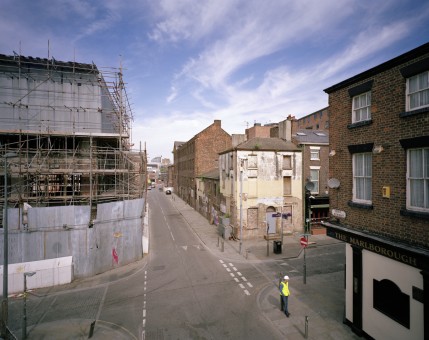I have recently become interested in the work of John Davies, which sparked my research into the Cities on the Edge exhibition. Davies curated the exhibit and his own contribution to the exhibition is worth some discussion along with my own reflections as I embark on the research for the final assignment.
Davies’ style is recognisable and quite unique in its approach to capturing the urban landscape. His long term project ‘The British Landscape’ aims to show the upheavals Britain has undergone from a highly industrialised society to a post industrial society. The project focuses on the industrial heartlands of the country. His way of portraying these landscapes is subtle and understated, he states that he aims to “avoid imposing my own view of urban change” (Davies, 2012) and his visual style is distinguished by its almost panoramic views of the British landscape.
Frustratingly I found it quite difficult to source any images Davies contributed to the exhibition (I did not resort to finding a copy of the book). I did find one image of what I am assuming is Ropewalks in Liverpool, one of the areas Davies chose to document. The photo is somewhat typical of Davies’ style, especially in terms of finding a high vantage point to give the viewer a sense of the layout of the urban landscape. This choice of composition is important in giving the viewer a different way of looking at a public area, and one that most people would not get to see. Whilst this works very well with Davies’ images of very well known areas of Britain (New Street Station, Edgware Road, Elephant and Castle etc.) it is perhaps not as integral to this particular image. Even so it is important in understanding the context of the exhibit and many of those who would viewed it (in Liverpool) would perhaps be familiar with the Ropewalks area. Giving us these unusual and ‘birds eye’ style vantage points allow us to consider urban landscapes we are familiar with in a different way.

The image itself is useful in showing the viewer how an urban landscape can change. We can see evidence of industrial and economic decline in the form of the run down warehouses in the background and the gutted Victorian house. The builder (?) in the florescent jacket and the development on the left hand side could perhaps be considered as agents of change. The typical working class pub on the right hand side is evidence of how some aspects of a city can be constant and show how some social mores are maintained through the generations, even in the face of industrial decline and social upheaval.
Whilst this image is a useful one to analyse and compare with other contributors to the exhibit, it is perhaps only a taster. I will try and source the rest of his images and do another post that examines the rest of his commission in the near future, and perhaps also look at Davies’ portfolio in greater depth. However, taking into account my research into the work of Taptik and Volz for the Cities on the Edge exhibit, I have outlined some points to be mindful of as I conduct the visual research for the final assignment:
- Over the last two assignments, the focus of my photography has shifted heavily towards documenting the urban landscape. I will therefore be looking at how I can channel this focus towards a well-considered commercial or professional brief that examines an aspect of the urban landscape, considering carefully the nature of the client.
- I will also need to decide whether I will include human subjects in my final images, and what sort of visual style I will be going for. Consulting with my tutor and gauging what the expectations are from the examiner will be vital in my final decision. Considerations about technique can also be factored into this.
- Finally it is worth noting here some inspirations or ideas I have had concerning the final assignment. I have noted on John Davies’ website commissions (the ‘monographs’) that range from sets about French motorways (‘Autoroute A26’) to sets covering major construction projects (‘Phase 11’). Deciding upon a brief that fits similar parameters could make for an interesting project, however I will need to be mindful of time and logistical constraints.
Examining the Cities on the Edge project has been a worthwhile process and has informed the early stages of my visual research for the final assignment. I will be examining the images I have captured so far in depth and posting them on here as soon as possible, whilst continuing with my research into other artists simultaneously.